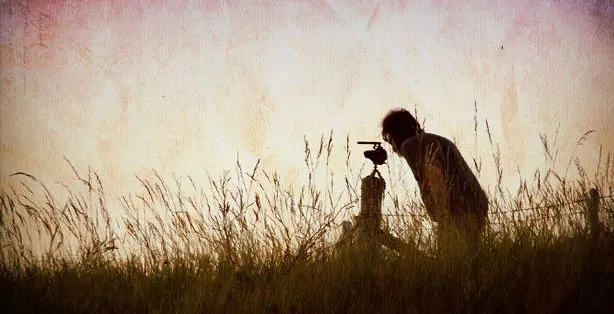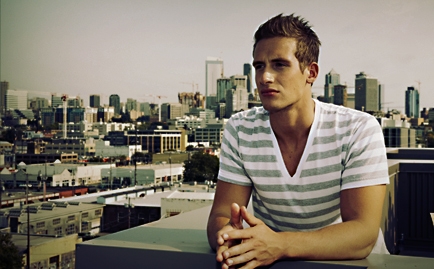
It was in the sludge of dirt, litter and sewage of Kibera, Africa’s second largest slum, that Dan Parris found the paradox of suffering and hope. Walking through the paths between tent-like homes in 2005, joyful children living in despair grabbed his hands to walk with him. It was here where Parris started to give a damn about extreme poverty. In 2009, Parris returned to Kibera where it all started and nearly ended this past August when he narrowly escaped death in a plane crash.
In May of 2009, Parris walked across a stage at Biola University, was handed his diploma and left to live an atypical college graduate life—one in poverty. He had convinced friend and atheist Rob Lehr who doesn’t think poverty is his responsibility, to live on $1.25 a day to make a documentary on global poverty titled Give A D–n?
The two set out for Africa in July from St. Louis, Mo., with friend and fellow crewmember David Peterka with the mission to connect those who need something to live for with those who just need something to live.
“There are intelligent and capable people everywhere—even those in extreme poverty,” Parris says.
However, after one month of travel and on their second day in Africa, tragedy struck.
On Aug. 1, Parris and Lehr contracted a small Cessna 206 plane in Nairobi, Kenya to shoot aerial footage of Kibera. After circling the area a couple of times, the engine suddenly slowed and the plane began to descend.
Parris looked at the pilot and engineer moving frantically in the front seat of the plane. As one of them jerked the controls up once and then twice, he realized the plane wasn’t going up. Two power lines came into view. Parris shook violently as the plane crashed into the power lines and plummeted to the ground, hitting a building before landing upside down.
“I didn’t have enough time to think, ‘God, help me,’” Parris says. “Only, ‘I’m going to die.’”
The trip was dangerous from the outset. The trio hitchhiked from St. Louis to New York, before flying to Europe, where they couch-surfed and lived on the streets for several weeks before heading to East Africa. The three spent their entire trip living on only $1.25 a day—the amount that 1.4 billion people living in “extreme poverty” survive on each day.
Making their way through Europe, they measured currency rates on the cost of a Big Mac at McDonald’s, often purchasing hamburgers for lunch and waiting for someone to leave a part of their meal at a table. They slept anywhere from friends of friends’ homes to park benches, and even camped on the White Cliffs of Dover in a heavy rainstorm one night.
The team didn’t just set out to document themselves—they hoped to document poverty the way others view it and how it is lived, not simply in Africa but across the globe. Interviewing experts and people on the street, rich and poor, the documentary sought to highlight possible solutions in the war on extreme poverty. They learned that although they were making an attempt to live in poverty, the truth was they would need to go deeper, that living in poverty would mean drinking unclean water and not having $1.25 each day.
When the plane crashed, the pilot, Frank Toews, died on impact. Flight mechanic Ryan Williams succumbed to his injuries a few days after the crash.
Knocked unconscious, Parris didn’t move once the plane hit the ground. Lehr escaped from the plane as it caught on fire. He woke Parris and helped him out of the plane, only to go back into the flames to help the unconscious Williams before being pulled back out of the wreckage himself.
The Kibera locals helped Lehr and Parris into a car, which immediately sped away, swerving to avoid cars as the driver drove between lanes to rush them to the hospital. Peterka and his brother, Tim, who met the trio in Africa to help with the film, rushed to the hospital as soon as they heard.
Parris had broken his collarbone and had a compression fracture at his L3 vertebrae, a paralytic ileus and several other minor injuries. Lehr had six stitches on his head and burns on his legs, arms and back. In the midst of it all, they didn’t stop filming, videoing Parris in his hospital bed with a camera phone. The team knew this was ultimately part of the bigger story they would be telling.
Although, their original planned two months in Africa was instantly reduced to one and a half days, as Parris and Lehr flew back to the U.S. to recover from injuries, they knew the story did not lie solely in Kibera—or poverty, for that matter.
Although the film’s focus is on global poverty, Parris hopes the film will inspire others to act in some way.
“Do what breaks your heart. Maybe it’s sex trafficking or the elderly or children,” Parris says. “I would like for some people’s lives to change because of this documentary, but ultimately I want people to say, ‘I could just do a little bit.’”
Plagued by health issues since they returned, Parris wasn’t able to commence editing until recently—the part of Give A D–n? he has been looking forward to for three years.
“With a documentary, when you edit the story, you are really writing it,” he says.
Hoping to finish the film for submission to the Sundance Film Festival 2011, Parris is continually finding encouragement and inspiration through his continuous setbacks.
“No matter how many ups and downs there are, there is always a consistent faith that this film is going to do something big,” he says. “I believe God is going to use it and do something incredible when all is said and done.”
To learn more about the documentary, visit its website here.





















